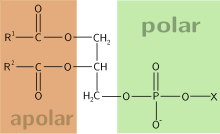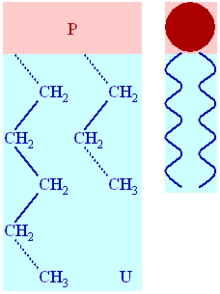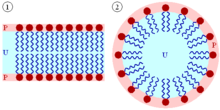Phospholipid
The phospholipids are a type of saponifiable lipids that make up cell membranes, made up of an alcohol molecule (glycerol or sphingosine), to which two fatty acids (1,2- diacylglycerol) and a phosphate group. Phosphate is attached by a phosphodiester bond to other molecules, which generally contain nitrogen, such as choline, serine, or ethanolamine, and often has an electrical charge. All active plasma cell membranes possess a phospholipid bilayer.
Phospholipids are divided into phosphoglycerides (where the alcohol is glycerol, a short-chain alcohol) and sphingolipids (the alcohol is sphingosine, a long-chain alcohol). The most abundant phospholipids are phosphatidylethanolamine (or cephalin), phosphatidylinositol, phosphatidic acid, phosphatidylcholine (or lecithin), and phosphatidylserine.
Companies such as Lipoid, Avanti Polar or VAV Life Sciences commercially produce purified phospholipids, for which applications have been found in nanotechnology and materials science.
Functions of phospholipids
- Structural component of the cell membrane: The amphipatic character of phospholipids allows them to self-association through hydrophobic interactions between the portions of long-chain fatty acid of adjacent molecules in such a way that the polar heads are projected outside, towards the water where they can interact with the protein molecules and the apolar tail is projected into the inside of the lipidic bilay.
- Enzyme activation: Fosfollipids participate as second messengers in the transmission of signals inside the cell as the diacilglicerol or phosphatidylcholine that activates the betahydroxybutirato dehydrogenase that is a mitochondrial enzyme.
- Components of pulmonary surfactant: The normal functioning of the lung requires the constant contribution of an uncommon phospholipid called dipalmitoylfosphatidylcholine. This tensoactive phospholipid is produced by type II epithelial cells and prevents atelectasis at the end of the breathing expiration phase.
- Detergent component of bile: Phospholipids, and especially phosphatidylcholine of bile, solubilize cholesterol. A decrease in the production of phospholipid and its secretion to bile causes the formation of calculus calculus of cholesterol and bile pigments.
- Synthesis of cell signaling substances: Phosphatidinol and phosphatidylcholine act as arachidonic acid donor for the synthesis of prostaglandins, tromboxans, leucotrienos and related compounds.
They are attached to 2 identical or different fatty acids.
Contenido relacionado
Dendrite
Classification of plants
Special botany


